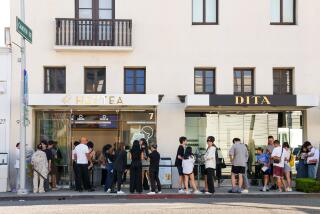Market Watch: The best mandarins are usually from farmers markets
Mandarins at their best are arguably the finest-flavored of all citrus, and clementines are potentially among the best of mandarins. California farmers have planted them on tens of thousands of acres over the last decade, and they are readily available in supermarkets, but there are several reasons, regarding variety, growing area, ripeness and post-harvest, for searching them out at farmers markets.
By the traditional account, the original clementine originated in a planting of mandarin seedlings made by Father Clement Rodier in the garden of an orphanage in Oran, Algeria, in the late 1890s. It flourished in the Mediterranean climate of North Africa and Spain, producing fruits of modest size but easy to peel, with rich, complex flavor, and seedless when grown apart from other citrus with viable pollen. In recent years, analyses of the fruit’s molecular markers have shown that, as for many mandarins, sweet orange played a role in its ancestry.
In 1914, this original clementine was brought to California, where it became known as Algerian; a similar strain called Fina was the chief variety in Spain until the 1960s. A larger-fruited, higher-yielding and slightly earlier bud mutation of Fina, Nules, discovered in 1953, is now the dominant commercial variety in Spain and California. It’s good, but not quite as rich and aromatic as the original varieties. Even at farmers markets, vendors typically do not bother to state the particular variety of clementine, but more than a dozen have been planted in California. Arnett Farms of Fresno, which sells at many markets, including Hollywood, Torrance, Manhattan Beach and Mar Vista, deserves kudos for specifying that they sell the superior Algerian variety.
The pioneer growers who planted huge acreage of clementines in the San Joaquin Valley in the 1990s and early 2000s gambled that they’d be able to produce large quantities of fruit with excellent flavor. They were hoping for a home run, but it turned out to be at best a double. The flavor is good, but not truly superb, and the fruits can be seedy when grown next to other seedy citrus, forcing many growers to install bee-proof nets over their crops during bloom.
The ideal growing area for clementines is actually a more Mediterranean climate like that of north San Diego County, where moderately inland districts such as Valley Center and Fallbrook produce mind-bogglingly delicious fruit, although the season is a month or two later, starting in late December or January and running as late as April.
The commercial season for San Joaquin Valley clementines starts as early as the beginning of November, but very often these fruits have been harvested slightly green and gassed with ethylene to deepen their color, which is not ideal for fruit flavor. In fact, perhaps because of the very excellence and delicacy of their aroma, mandarins are the most susceptible of citrus to loss of flavor from commercial packing and shipping. Scientists have studied how washing, waxing, jostling, refrigeration and storage — all unavoidable when fruit is shipped cross-country — take their toll on mandarins, leading to a drop in the acidity that lends the fruit its pleasing tang, and the development of off-flavors.
The upshot is, we in Southern California are fortunate to be able to buy clementines at farmers markets, just a day or two off the tree.
Safety feature
In a few weeks, visitors to the Santa Monica markets at Third Street and Arizona Avenue may be puzzled by what will appear to be tennis nets at the market entrances. They should not bring their rackets, however: These actually will be steel-mesh nets intended to protect the market from traffic.
In July 2003, a runaway car killed 10 people and injured 63, and this tragedy cost the City of Santa Monica $21 million to settle dozens of lawsuits. Since then the market has hired police officers to station their cruisers at each end of the market, four on Wednesday and two for the smaller market on Saturday; the cars serve as barriers that can be quickly moved to allow essential traffic such as firetrucks and late-arriving farmers to pass.
Expenses for the police and their cars run about $172,000 annually, and installation of the nets will cost just under $200,000 but save $121,000 yearly, according to budget estimates prepared by city staff.
On Wednesday morning, Laura Avery, who supervises the Santa Monica markets, toured the sites with a crew of engineers and contractors as they deciphered the cryptic writings on the pavement, indicating the presence of utility lines below, and tried to determine the best locations for the nets. The steel shafts that will support them will be set 4 feet into the ground, and there will be two parallel nets at each entrance, 18 inches apart. Market staff can readily lower the nets to allow traffic through if necessary.
The nets are designed to stop wayward vehicles going at speeds up to 30 mph in a way that is relatively safe for such errant drivers, compared with hard barricades such as bollards. There will be a clearance of 9 feet beyond the placement of the posts, to accommodate the nets’ stretching if used.
Avery is working with engineers and contractors to try to ensure that the market’s footprint will not be adversely affected. There is no truth to the rumor that Pete Sampras will be present for the official unveiling of the nets, she joked.
More to Read
Eat your way across L.A.
Get our weekly Tasting Notes newsletter for reviews, news and more.
You may occasionally receive promotional content from the Los Angeles Times.










